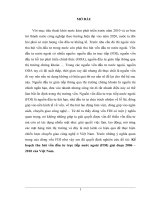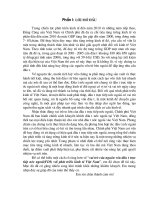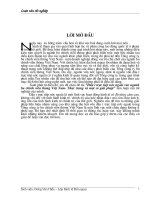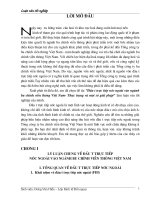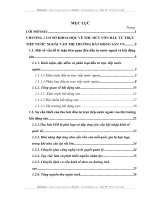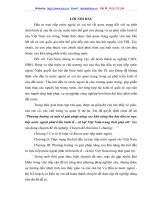XÁC ĐỊNH MỐI QUAN HỆ GIỮA NGUỒN ĐẦU TƯ TRỰC TIẾP NƯỚC NGOÀI VÀ CÁN CÂN THƯƠNG MẠI Ở VIỆT NAM
Bạn đang xem bản rút gọn của tài liệu. Xem và tải ngay bản đầy đủ của tài liệu tại đây (1.01 MB, 11 trang )
<span class='text_page_counter'>(1)</span><div class='page_container' data-page=1></div>
<span class='text_page_counter'>(2)</span><div class='page_container' data-page=2>
<i> </i>
T¹p chÝ Khoa häc và Công nghệ
CHUYấN SAN KHOA HỌC XÃ HỘI – NHÂN VĂN – KINH TẾ
Mơc lơc
Trang
Bùi Hồng Tân - Tình hình sở hữu ruộng đất công ở huyện Hà Châu, tỉnh Hà Tiên qua nghiên cứu tư liệu địa bạ
năm Minh Mạng thứ 17 (1836) 3
Đoàn Thị Yến - Vua Tự Đức với vấn đề Công giáo trước và sau năm 1862 9
Trần Minh Thuận - Vấn đề ruộng đất và các cuộc đấu tranh tự phát của nông dân ở tỉnh Bạc Liêu thời
Pháp thuộc 15
Đồng Văn Quân - Các kiểu chế độ dân chủ trong lịch sử và nền dân chủ xã hội chủ nghĩa ở nước ta hiện nay 21
Lê Thị Giang, Lê Thị Hương - Nguồn gốc hình thành tư tưởng Hồ Chí Minh về con người và xây dựng
con người 27
Cao Thị Phương Nhung, Ngô Thị Quang - Chủ tịch Hồ Chí Minh bàn về cơng tác học tập lí luận trong tác
phẩm “Diễn văn khai mạc lớp học lí luận khóa I trường Nguyễn Ái Quốc” 33
Lưu Thu Trang - Bi kịch của nhân vật Grigori Melekhov qua mối quan hệ với hai nhân vật nữ Aksinia và
<i>Natalia trong tác phẩm Sông Đơng êm đềm (M. Sholokhov) </i> 39
<i>Hồng Thị Tuyết Mai - Thế giới trăng trong thơ Nguyễn Huy Oánh </i> 45
Nguyễn Diệu Linh - Cá sỉnh trong văn hóa ẩm thực của người Thái trắng ở xã Sơn A, huyện Văn Chấn, tỉnh
Yên Bái 49
Nguyễn Thị Tân Tiến, Hà Thị Hằng - Sự khác biệt về kết quả chuẩn đầu ra tin học của sinh viên học học phần
Tin học đại cương với sinh viên đạt chứng chỉ IC3 ở trường Đại học Y – Dược, Đại học Thái Nguyên 55
Đầu Thị Thu - Rèn luyện nghiệp vụ sư phạm cho sinh viên thông qua hoạt động trải nghiệm thực tế nghề nghiệp 61
Nguyễn Ngọc Bính, Dương Tố Quỳnh - Thực trạng công tác kiểm tra, đánh giá kết quả học tập mơn bóng
chuyền cho sinh viên trường Đại học Kinh tế và Quản trị Kinh doanh - Đại học Thái Nguyên 67
Lưu Quang Sáng - Một số phương pháp dạy học chữ Hán cho người Việt 73
Hoàng Thị Hải Yến - Vận dụng tư tưởng Hồ Chí Minh về đạo đức trong việc xây dựng đạo đức, lối sống cho
<i>sinh viên trường Đại học Kỹ thuật Công nghiệp – Đại học Thái Nguyên hiện nay </i>79
<i>Phùng Thị Tuyết, Nông Hồng Hạnh - Đánh giá trong dạy học qua đề án ở bộ môn tiếng Trung Quốc - Khoa </i>
Ngoại ngữ - Đại học Thái Nguyên 85
Trần Hoàng Tinh - Thực trạng và biện pháp xây dựng kế hoạch, chỉ đạo thực hiện giáo dục tính kỷ luật cho
sinh viên tại Trung tâm Giáo dục Quốc phòng và An ninh 91
Hồng Thị Lý - Vai trị của hoạt động giàn giáo trong việc làm tăng khả năng đọc hiểu tiếng Anh của sinh viên
năm nhất 97
Dương Thị Hồng An, Đặng Phương Mai - Đánh giá phần mềm hỗ trợ học tập và giảng dạy tiếng Anh tại
trường Đại học Công nghệ Thông tin và Truyền thông – Đại học Thái Nguyên 103
Tạ Thị Mai Hương, Nguyễn Vân Thịnh, Nguyễn Thị Hạnh Hồng - Tác động của việc sử dụng hồ sơ bài tập
lên sự phát triển kĩ năng nghe hiểu của sinh viên: nghiên cứu trường hợp tại trường Đại học Kinh tế và Quản trị
Kinh doanh – Đại học Thái Nguyên 109
Trần Tuấn Anh, Đỗ Văn Hải, Trần Thị Thu Thủy, Hoàng Văn Hùng - Nghiên cứu xây dựng cơ sở dữ liệu
đất đai đa mục tiêu phục vụ công tác quản lý tại phường Cốc Lếu, thành phố Lào Cai 115
Nguyễn Thị Gấm, Đào Thị Hương - Ảnh hưởng của chất lượng dịch vụ ngân hàng tới sự thỏa mãn của khách
hàng tại Vietinbank - chi nhánh Thái Nguyên 121
Nguyễn Thị Thanh Thủy - Đầu tư trực tiếp nước ngoài với sự phát triển kinh tế - xã hội Việt Nam 129
Journal of Science and Technology
175
(15)
</div>
<span class='text_page_counter'>(3)</span><div class='page_container' data-page=3>
Chu Thị Hà, Đỗ Thị Hà Phương, Nguyễn Thị Giang, Lin Xiao Wu - Nhân tố ảnh hưởng đến động lực làm
việc của người lao động tri thức tại Việt Nam 135
Trần Viết Khanh, Đỗ Thúy Mùi - Một số giải pháp phát triển nông nghiệp vùng Tây Bắc 141
Nguyễn Thị Lan Anh - Tăng cường quản lý sử dụng kinh phí cho hoạt động y tế tại Bệnh viện Đa khoa Trung
ương Thái Nguyên 147
Nguyễn Thị Giang, Đỗ Thị Hà Phương, Chu Thị Hà, Hồ Lương Xinh - Hiệu quả kinh tế trong sản xuất nấm
ăn của các hộ gia đình ở huyện Đại Từ, tỉnh Thái Nguyên 153
<i>Đỗ Thị Vân Hương - Phân tích hiệu quả mơ hình trồng cây cà phê chè (Arabica), cây mắc ca (Macadamia) tại </i>
xã Ẳng Tở, huyện Mường Ảng, tỉnh Điện Biên 159
Đặng Ngọc Huyền Trang, Dương Thị Thùy Linh - Xác định mối quan hệ giữa nguồn đầu tư trực tiếp nước
ngoài và cán cân thương mại ở Việt Nam 165
<i>Dương Thị Tình - Thực trạng tái cơ cấu doanh nghiệp nhà nước năm 2016 và giải pháp cho những năm tiếp theo </i> 171
Phạm Thị Thanh Mai, Nghiêm Thị Ngoan - Đảm bảo quyền sở hữu trí tuệ đối với sản phẩm chè mang chỉ dẫn
địa lý “Tân Cương” của tỉnh Thái Nguyên 177
Nguyễn Thị Thảo - Kết quả thực hiện chương trình giảm nghèo tỉnh Thái Nguyên giai đoạn 2011-2015 183
Nguyễn Thị Lan Anh, Đào Thị Hương - Phát triển mối liên kết các tác nhân trong chuỗi giá trị ngành hàng chè
tỉnh Thái Nguyên 189
Trần Thùy Linh, Đỗ Hoàng Yến - Hoàn thiện các quy định về xác định hành vi lạm dụng vị trí thống lĩnh thị
trường theo Luật Cạnh tranh 2004 195
Nguyễn Thị Mỹ Hạnh, Ngô Thị Quỳnh Trang, Phạm Thị Thu Phương, Hoàng Thị Lan Hương - Các rào
cản trong việc áp dụng tiêu chuẩn khách sạn xanh ASEAN tại Hà Nội 201
Phan Thị Vân Giang, Phạm Bảo Dương - Một số vấn đề lý luận và bài học kinh nghiệm liên kết kinh tế trong
</div>
<span class='text_page_counter'>(4)</span><div class='page_container' data-page=4>
<i>Đặng Ngọc Huyền Trang và Đtg </i> Tạp chí KHOA HỌC & CƠNG NGHỆ 175(15): 165 - 170
165
DETERMINING RELATIONSHIP BETWEEN FOREIGN DIRECT
INVESTMENT INFLOW AND TRADE BALANCE IN VIETNAM
Dang Ngoc Huyen Trang*, Duong Thi Thuy Linh
<i>TNU University of Technology </i>
SUMMARY
Foreign direct investment (FDI) inflows and trade balance are two important factors in balance of
payment. In Vietnam, quite a long time trade account always is deficit and FDI inflows is higher
than FDI outflows. Does the success in attracting FDI cause trade balance be deficit? Johansen test
for cointegration result confirms the long run moving together between them in Vietnam. From
some characteristics of FDI infows, export and import values, we want to find the long run
relationship between them by using Johansen test for cointegration and then using vector
error-correction model to find the long run and short run causality running from export and import
values to FDI inflows. Then we find the causality in short run and long run running from trade
balance to FDI.
<i>Key words: FDI; export; import; unit root; Johansen test; causality. </i>
INTRODUCTION *
An inward investment involves an external or
foreign entity either investing in or
purchasing the goods of a local economy. A
common type of inward investment is a
foreign direct investment (FDI). This occurs
when one company purchases another
business or establishes new operations for an
existing business in a country different than
the investing company's origin.
In developing or low income countries,
investment demand is larger than saving, the
outsourcing is very important to robust the
development of economies. Vietnam is in the
same situation. By reforming economy and
opening the door, Vietnamese economy can
gain high growth rate, average rate during
period 1990 – 2015 was above 6.5% (World
Bank) [9] where the role of FDI would not be
ignore. FDI helps increase amount of
employment, compensate the shortage of
capital to increase investment, enhance the
transfer of technology and promotes the
integration in the global economy.... but The
most important role of FDI enterprises in
Vietnam is to increase in export value of
Vietnam. Their export values were around
57.2% and 62.5% in 2005 and 2014
*
<i>Tel: 0915208709; Email: </i>
respectively, helping the national economic
open and integration of economic
globalization.
The FDI inward including numbers of projects,
total registered capital and implementation
capital increase as time path, detail in figure1.
Particularly, shardly increasing in 2008 of
registered capital, but falled after that, however
the implementation capital increase all phrase
from 1990 to 2014. Vietnam is successful in
attracting FDI inflow in ASEAN only after
Singapore in recent years, detail in figure 2.
After 2012 FDI inflow in Vietnam is nearly
close to Thailand and Malaysia and far from
other countries likely Lao, Combodia,
Myanmar, Philippin. Specially, the speed of
increasing FDI inflow is quite smooth, it is not
likely Malaysia or Thailand, fluctuating a lot,
particularly recent years. VietnameseFDI
ourward, the value is very small at the
beginning of period 1990-2014 and then
increase some years in the mid, after that it
continues to decrease. In short, FDI outflow is
small value and unstability in all period from
1991 to 2014.
</div>
<span class='text_page_counter'>(5)</span><div class='page_container' data-page=5>
<i>Đặng Ngọc Huyền Trang và Đtg </i> Tạp chí KHOA HỌC & CƠNG NGHỆ 175(15): 165 - 170
166
surplus some recent years from 2012 (World
Bank) [9]. Secondly, the export value from
domestic sector decrease from around 73% in
1995 to 32.6% in 2014 whereas foreigned
sector’s export values increase from around
29.7% to 76.4%.
<i>Figure 1. FDI projects licensed during period </i>
<i>1988 – 2015 </i>
<i>(Source: General Statistics Office of Vietnam [8]) </i>
<i>Figure 2. FDI inflows in some countries in ASEAN </i>
<i>(Source: UNCTAD [7]) </i>
Thirdly, the import value from the domestic
sector is around 82% and 43% in 1995 and
2014 respectively, while foreigned sector’s
import value is 18% and 57%, shown in
figure 3, 4 and 5. The most important thing,
Vietnam signed FTAs and have trade
relationship with many partners over the
world. Likely, in 1995 became member of
ASEAN (AFTA), Vietnam- USA bilateral
trade Agrement in 2000; Asean – China FTA
(2004); Asean – Korea (2006), member of
WTO in 2007;… Only in 2013, Vietnam had
trade goods and services with 240 countries
and territories (VCCI). These events can help
Vietnam is easier to import and export goods
and services to the rest of the world.
From some characteristics of FDI infow,
export and import values We want to find the
long run relationship between them by using
Johansen test for cointegration and then using
vector error-correction model to find the long
run and short run causality running from
export and import values to FDI inflow.
<i>Figure 3. Exports and imports (% of GDP) </i>
<i> (Source: Worldbank [9] </i>
<i>Figure 4. Export values by kinds of economic sectors </i>
<i>(Source: General Statistics Office of Vietnam [10]) </i>
<i>Figure 5. Imports values by kinds of economic sectors </i>
</div>
<span class='text_page_counter'>(6)</span><div class='page_container' data-page=6>
<i>Đặng Ngọc Huyền Trang và Đtg </i> Tạp chí KHOA HỌC & CƠNG NGHỆ 175(15): 165 - 170
167
SOME LITERATURES ABOUT THE
FACTORS AFFECTING ON FDI INFLOW
IN VIETNAM
A numorous literatures study about the factors
affecting to attract FDI inflow. In Vietnam,
researchers find some factors affect on
attracting FDI inflow as follows:
Hoang Thi Thu (2010) [5] using OLS
estimation method to determine the factors
attracting the FDI in Vietnam and finding that
market size, GDP growth, trade openness and
better infrastructure development are factors,
but not found a strong relationship between
FDI and human capital quality. Tam Bang Vu
(2008)[4] using time-varying coefficients in an
augmented production function and let FDI
indirectly affect Gross domestic product
growth through labor productivity and find that
FDI has significant and positive effect on labor
productivity and economic growth in Vietnam,
but the effect is not equally distributed among
economic sectors. Hoang Thi Thu (2010) [5]
using panel data method across sixty-one
provines in 1995-2006 shows the strong and
positive the effect of FDI on growing the
Vietnamese economy.
Le Hoang Ba Huyen (2015) [3] using
questionaires to determine the main factors
affect on attracting FDI in Thanh Hoa
provine. The result shows that availability of
resources factors, infrastructure factors and
financial factors are significant. Shiba
Shankar (2016) [6] using Johnson
Co-integration test for find out the long run
relationship between GDP, FDI. Danish
Ahmed Siddiqui (2013) [1] using Johansen
Juselius co-integration technique and the
Granger causality test and find out the long
run relationship between FDI and current
account and long run causality between FDI
and current account in Pakistan economy.
James P. Walsh (2010) [2] using a GMM
dynamic approach to address concerns about
endogeneity and analyze the various
macroeconomic, developmental, and
institutional/qualitative determinants of FDI
in a sample of emerging market and
developed economies.
For this study I will find the long run
relationship between FDI, export and import
value in Vietnam by using Johansen test
co-integration and running vector error correction
model to find out the short run and long run
causality between FDI, export and import.
DATA, METHODOLOGY
To reinforce this relationship between FDI,
export and import I use data from 1996 to 2014
and Johansen tests for cointegration and then
testing the causality running from exportation
and importation to FDI inflow. For this study
data have been taken from two sources as
dependent variable and independent variables.
Dependent variable is inward Foreign Direct
Investment (FDI), Inward FDI data is extracted
from UNCTAD database.
Independent variables include export and
import goods and services as percentage of
GDP. They are extracted from Worldbank. I
have given co-integration equation:
LFDIt = αo+β1Exportt+β2Importt+Ut
Where LFDIt : natural log of total inward FDI
in period t; exportt as a share of GDP in
period t=export/GDP; Importt as a share of
GDP in period t=import/GDP; Ut is
disturbance.
To use Johansen co-integration test all
variables must be non-stationary in level and
stationary in the first order different. To serve
my purpose Augmented Dickey Fuller (ADF)
test is applied to check unit root of variables
and then if existing co-integration between
them I use the VECM to find the long run and
short run causality between FDI inflow,
export and import.
RESULTS
Unit root test
</div>
<span class='text_page_counter'>(7)</span><div class='page_container' data-page=7>
<i>Đặng Ngọc Huyền Trang và Đtg </i> Tạp chí KHOA HỌC & CƠNG NGHỆ 175(15): 165 - 170
168
<i>Table 1. Augmented Dickey Fuller test (at level) </i>
Variables Trace
statistic
1% Critical
value
5% Critical
value
10% Critical
value Result
-3.750 -3.000 -2.630
lFDI -0.214 Significant at 1%
Export -0.155 Significant at 1%
Import -0.852 Significant at 1%
<i>(Source: Data base compiled by author) </i>
Absolute value of Trace statistic is less than critical value at 1%, all variables are non-stationary
in level. Then I test unit root for the first different of all variables and the result in table 2.
<i>Table 2. Augmented Dickey Fuller test (at first different) </i>
Variables Trace
statistic
1% Critical
value
5% Critical
value
10% Critical
value Result
-3.750 -3.000 -2.630
lFDI -2.690 Significant at 10%
Export -3.982 Significant at 1%
Import -4.470 Significant at 1%
<i>(Source: Data base compiled by author) </i>
Absolute value of trace statistic of export and import is greater than critical value at 1%, meaning
that they are stationary in the first different at 1%, absolute value of trace statistic of natural
logarithm of FDI is greater than critical value at 10%, lFDI is stationary at 10% in the first
different. It shows all the variables of our study are integrated of order one.
Co-integration Test
After ADF test for all variables at level and at first different, satisfying condition to test Johansen
co-integration, we have the result as table 3. We see both trace statistics and max statistics give
the same result. Absolute Trace statistic is 13.09 is less than critical value 15.41 at 5%. And max
statistic is 13.01 is less than critical value at 5%. That is the number of co-integration between
three variables equals one. We can conclude foreign direct investment inflow, export and import
have long run relationships, meaning that they move together in the long run. Because three
variables are co-integration, we can run VECM model to find the long run and short run causality
between them.
<i>Table 3. Johansen tests for cointegration </i>
Johansen testa for cointegration
Trend: conatant Number of oba = 16
Sample: 1999-2014 Lags = 3
maximum
rank parms LL eigenvalue statistic trace 5% critical value
0 21 -67.856956 53.1337 29.68
1 26 -47.836806 0.91812 13.0934 15.41
2 29 -41.327645 0.55676 0.0751 3.76
3 30 -41.290106 0.00468
maximum
rank parms LL eigenvalue statistic max 5% critical value
0 21 -67.856956 40.0403 20.97
1 26 -47.836806 0.91812 13.0183 14.07
2 29 -41.327645 0.55676 0.0751 3.76
3 30 -41.290106 0.00468
</div>
<span class='text_page_counter'>(8)</span><div class='page_container' data-page=8>
<i>Đặng Ngọc Huyền Trang và Đtg </i> Tạp chí KHOA HỌC & CƠNG NGHỆ 175(15): 165 - 170
169
<i>Table 4. VECM model with log of FDI inflow as dependent variable </i>
( 1) [ D_lfdi] LD.export = 0 ( 1) [ D_lfdi] LD.import = 0
( 2) [ D_lfdi] L2D. export = 0 ( 2) [ D_lfdi] L2D. import = 0
chi2( 2) = 19.71
Prob > chi2 = 0.0001
chi2( 2) = 14.60
Prob > chi2 = 0.0007
<i>(Source: Data base compiled by author) </i>
<i>Table 5. Testing short run causality jointly running from export lag and import lag to FDI </i>
coef. Std. Err. z P> (95% Conf. Interval)
D_lfdi
_cel
L1. -.5852405 .1654529 -3.54 0.000 -.9095222 -.2609589
Lfdi
LD. .2563259 .2346701 1.09 0.275 -.203619 .7162708
L2D .0008458 .2292424 0.00 0. 997 -.448461 .4501526
export
LD. .0055525 .014846 0.37 0.708 -.0235451 .03465
L2D. .0677006 .0153918 4.40 0.000 .0375331 .097868
import
LD. -.032951 .0169294 -1. 95 0.052 -.0661319 .00023
L2D. -.0579207 .0153619 -3.77 0.000 -.0880295 -.0278119
_cons -.2757553 .0978923 -2.82 0.005 -.4676207 -.0838899
<i>(Source: Data base compiled by author) </i>
Vector Error Correction Model
I use the FRE criterion to select the lag order
to run regression and the number of lags used
is three, the result as in table 4. Coefficient of
ce1 is negative and P-value is zero, meaning
that the long run causality running from
export and import to FDI inflow is significant,
meaning that in the long run export and
import cause FDI inflow in Vietnam.
How about the short run causality, export lag
2 and import lag 2 are significant, they affect
on the FDI. However, export lag 1 and import
lag 1 in short run do not cause FDI inflow. I
take add more one test to know export lag 1
and export lag 2 jointly affect on FDI and
import lag 1 and import lag2 jointly affect on
FDI. The result is as in table 5. Theprobability
for both export lag 1, export lag 2 and import
lag1, import lag 2 are jointly causality to FDI
is significant, meaning that export lag1 and
lag2 jointly affect on FDI inflow in the short
run and the same with import lag1 and lag2
on FDI inflow.
CONCLUSION
Vietnam opened the door to foreigners to
invest and get successes. GDP per capita is
2052.319 current USD in 2014 (World Bank)
[9], average economic growth in period
1995-2014 is above 6.5% (World Bank) [9],
openness index of economy calculated by
import plus export value over GDP increase
on the time path and get 178.76 in 2015.
Foreign capital resources contribute an
important role in this process. To attract more
FDI inflow beside other fundamental factors
like market size, exchange rate, GDP per
capita or improving infrastructure, laws,
financial system, open to trade is deciding
factor. This result is the same with Hoang Thi
Thu (2008) [5].
</div>
<span class='text_page_counter'>(9)</span><div class='page_container' data-page=9>
<i>Đặng Ngọc Huyền Trang và Đtg </i> Tạp chí KHOA HỌC & CƠNG NGHỆ 175(15): 165 - 170
170
However from the data and result analysis we
can see the cause of attraction of FDI inflow
is easy to take advantage conditions
inexportation and importation. The value of
both importation and exportation increase
significantly from FDI enterprises and
decrease significantly from domestic sector.
This signal is not good for the domestic
sectors. The input and technology for
production process of FDI enterprises are
imported, meaning that domestic sectors have
less roles in the supply chain of theirs so they
are easy to change to other countries if
Vietnamese investment conditions become
more difficult or government want to tight
more conditions likely increasing taxes or
environmental dispute.
Secondly, the value of exportation of
domestic sectors decreases significantly
following the time. This condition can prove
that the competitiveness capacity of
Vietnamese enterprises is falling in the
international market.
Thirdly, Vietnam had signed the free trade
agreements in order to facilitate the import
and export activities. However, the import-
export value of the domestic sector has
decreased over time, which indicates that only
the FDI sector has taken advantages of these
incentives. This reason may be the most
important one why foreign direct investments
want to invest in Vietnam.
REFERENCE
1. Danish Ahmed Siddiqui (2013), “The causal
relationship between Foreign Direct Investment and
Current Account: an empirical investigation for
<i>Pakistan economy”, Theoretical and Applied </i>
<i>Economics, Vol. XX, No. 8(585), pp. 93-106. </i>
2. James P. Walsh and Jiangyan Yu (2010),
“Determinants of Foreign Direct Investment: A
<i>Sectoral and Institutional Approach”, Asia Pacific </i>
<i>Department - IMF Working Paper, July 2010. </i>
3. Le Hoang Ba Huyen (2015), “Determinant of the
factors affecting Foreign Direct Investment (FDI)
flow to Thanh Hoa province in Vietnam”, Social and
<i>Behavioral Sciences 172,pp. 26 – 33 </i>
4. Tam Bang Vu (2008), “Foreign Direct Investment
<i>and Endogenous Growth in Vietnam”, Applied </i>
<i>Economics, Vol. 40, No. 9,pp. 1165-1173. </i>
5. Hoang Thi Thu (2010), “Does Foreign Direct
Investment Promote Economic Growth in Vietnam?”
<i>ASEAN Economic Bulletin, Vol. 27, No. 3, p. 295. </i>
6. Shiba Shankar PATTAYAT (2006), “Examining
the determinants of FDI inflows in India”,
<i>Theoretical and Applied Economics , Vol XXIII </i>
<i>(2016), No. 2(607), Summer, pp. 225-238. </i>
7.
Cited 10 Sep 2017.
8.
ment/-/E04.11.px/?rxid=5a7f4db4-634a-4023-a3dd-c018a7cf951d, Cited 10 Sep 2017.
9.
GNFS. ZS , Cited 10 Sep 2017.
10.
=515, Cited 10 Sep 2017.
TÓM TẮT
XÁC ĐỊNH MỐI QUAN HỆ GIỮA NGUỒN ĐẦU TƯ TRỰC TIẾP NƯỚC NGOÀI
VÀ CÁN CÂN THƯƠNG MẠI Ở VIỆT NAM
Đặng Ngọc Huyền Trang*, Dương Thị Thùy Linh
<i>Trường Đại học Kỹ thuật Cơng nghiệp – ĐH Thái Ngun </i>
Dịng vốn đầu tư trực tiếp nước ngoài (FDI) và cán cân thương mại là hai yếu tố quan trọng trong
cán cân thanh toán. Trong khoảng thời gian dài (1986-2012) cán cân thương mại của Việt Nam
luôn bị thâm hụt và dịng vốn FDI chảy vào ln cao hơn. Thành cơng trong việc thu hút FDI có
phải là nguyên nhân khiến cho cán cân thương mại bị thâm hụt? Chúng tôi sử dụng kiểm định
Johansen tìm kiếm mối quan hệ nguyên nhân kết quả giữa cán cân thương mại và FDI. Bằng cách
sử dụng thử nghiệm Johansen để hợp nhất và sau đó sử dụng vạch lỗi chỉnh sửa, từ một số đặc
điểm của FDI, giá trị xuất khẩu và nhập khẩu, chúng tơi đã tìm ra bằng chứng cán cân thương mại
là một phần nguyên nhân dẫn đến thành công trong thu hút đầu tư trực tiếp nước ngoài ngay cả
trong ngắn hạn và dài hạn.
<i>Từ khóa: FDI; xuất khẩu; nhập khẩu; unit root; Johansen; quan hệ nhân quả. </i>
<i>Ngày nhận bài: 12/9/2017; Ngày phản biện: 07/11/2017; Ngày duyệt đăng: 29/12/2017 </i>
*
</div>
<span class='text_page_counter'>(10)</span><div class='page_container' data-page=10>
<i>oµ </i>
<i>soT</i>
T¹p chÝ Khoa học và Công nghệ
SOCIAL SCIENCE – HUMANITIES – ECONOMICS
Content
PageBui Hoang Tan - Ownership situation public field-land in Ha Chau district, Ha Tien province through studying
cadastral registers of Minh Mang dynasty 17 (1836) 3
Doan Thi Yen - Tu Duc king’s attitude towards Catholicism before and after 1962 9
Tran Minh Thuan - The land problems and spontaneous fights of farmers in Bac Lieu province under the
French domination 15
Dong Van Quan - Types of democratic regime in the history and the present socialist democratic regime in our
country 21
Le Thi Giang, Le Thi Huong - The original of formation of Ho Chi Minh thought on human beings, human
development 27
Cao Thi Phuong Nhung, Ngo Thi Quang - Ho Chi Minh’s talk about the study of theoretics in “the orientation
speech at the opening ceremony of the first theoretics class at Nguyen Ai Quoc Institute” 33
Luu Thu Trang - The tragedy of Grigori Melekhov reflected in the relationship between Aksinia and Natalia in
<i>Quietly Flows the Don (M. Sholokhov) </i> 39
Hoang Thi Tuyet Mai - The moon in Nguyen Huy Oanh’s poetry 45
<i>Nguyen Dieu Linh - Onychostoma laticeps in culinary culture of white Thai people in Son A commune, Van </i>
Chan district, Yen Bai province 49
Nguyen Thi Tan Tien, Ha Thi Hang - The diffrences of learning outcomes of students having taken the
general informatics course with students obtaining the IC3 certicate at Thai Nguyen University of Medicine and
Pharmacy 55
Dau Thi Thu - Training pedagogical profession for students through real professional activity experience 61
Nguyen Ngoc Binh, Duong To Quynh - Testing and assessing the learning outcome of the volleyball subject
for students at Thai Nguyen University of Economics and Business Administration 67
Luu Quang Sang - Some suggestions of teaching Chinese characters for Vietnamese students 73
Hoang Thi Hai Yen - Applying Ho Chi Minh’ ideology about morality in building morals, lifestyle of students
in Thai Nguyen University of Technology currently 79
Phung Thi Tuyet, Nong Hong Hanh - Assessment of the project-based teaching and learning of the students
major in Chinese at School of Foreign Languages, Thai Nguyen University 85
Tran Hoang Tinh - Situation and measures for planning and directing the implementation of disciplined
education for students at centers for national defense and security education 91
Hoang Thi Ly - role of scaffolding activities in enhancing english reading skills among first year college
students 97
Duong Thi Hong An, Dang Phuong Mai - Evaluating the EFL courseware at Thai Nguyen University of
Information and Communication Technology 103
Ta Thi Mai Huong, Nguyen Van Thinh, Nguyen Thi Hanh Hong - Effects of portforlios on improving listening
comprehension skill for students: a case study at Thai Nguyen University of Economics and Business
Administration 109
Tran Tuan Anh, Do Van Hai, Tran Thi Thu Thuy, Hoang Van Hung - Research building multipurpose
database to service land mangement in Coc Leu ward, Lao Cai city 115
Nguyen Thi Gam, Dao Thi Huong - Influence of service quality on customer satisfaction at Vietinbank- Thai
Nguyen branch 121
Nguyen Thi Thanh Thuy - Foreign direct investment with the socio-economic development of Vietnam 129
Journal of Science and Technology
175
(15)
</div>
<span class='text_page_counter'>(11)</span><div class='page_container' data-page=11>
Chu Thi Ha, Do Thi Ha Phuong, Nguyen Thi Giang, XiaoLi Wu - Factors affecting knowledge workers’ job
motivation in vietnamese enterprises 135
Tran Viet Khanh, Do Thuy Mui - Some agricultural development solutions in Tay Bac 141
Nguyen Thi Lan Anh - Enhanced management in use expense resources of health care activities in Thai
Nguyen National General Hospital 147
Nguyen Thi Giang, Do Thi Ha Phuong, Chu Thi Ha, Ho Luong Xinh - Solution to improve economic
efficiency of mushroom production at households in Dai Tu district, Thai Nguyen province 153
Do Thi Van Huong - Analyse efficiency of Arabica and Macadamia crops at Ang To commune, Muong Ang
district, Dien Bien province 159
Dang Ngoc Huyen Trang, Duong Thi Thuy Linh - Determining relationship between foreign direct
<i>investment inflow and trade balance in Vietnam </i> 165
Duong Thi Tinh - Status of restructuring state-owned enterprises in 2016 and solutions for next years 171
Pham Thi Thanh Mai, Nghiem Thi Ngoan - Guarantee for intellectual property rights on the "Tan Cuong" tea
geographical indications of Thai Nguyen province 177
Nguyen Thi Thao - Implementation results of the poverty reduction program in Thai Nguyen province in
2011-2015 183
Nguyen Thi Lan Anh, Dao Thi Huong - The development of the relationship between workers in the value
brand only chain in Thai Nguyen province 189
Tran Thuy Linh, Do Hoang Yen - Improving regulations on defining dominant abusive practices under
Vietnemese Competition Law 2004 195
Nguyen Thi My Hanh, Ngo Thi Quynh Trang, Pham Thi Thu Phuong, Hoang Thi Lan Huong - Barriers to
ASEAN green hotel standard in the hotel industry: a case study in Ha Noi 201
Phan Thi Van Giang, Pham Bao Duong - Some theoretical issues and experience lessons of integration in pig
raising and pork consumption 207
</div>
<!--links-->
